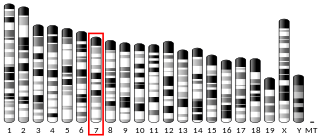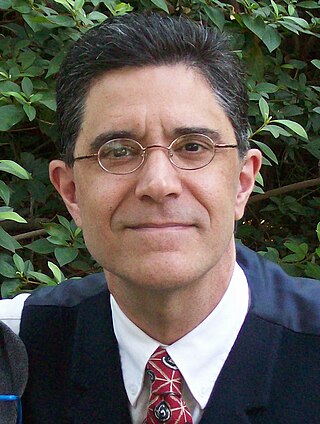
A circadian rhythm, or circadian cycle, is a natural oscillation that repeats roughly every 24 hours. Circadian rhythms can refer to any process that originates within an organism and responds to the environment. Circadian rhythms are regulated by a circadian clock whose primary function is to rhythmically co-ordinate biological processes so they occur at the correct time to maximize the fitness of an individual. Circadian rhythms have been widely observed in animals, plants, fungi and cyanobacteria and there is evidence that they evolved independently in each of these kingdoms of life.

Chronobiology is a field of biology that examines timing processes, including periodic (cyclic) phenomena in living organisms, such as their adaptation to solar- and lunar-related rhythms. These cycles are known as biological rhythms. Chronobiology comes from the ancient Greek χρόνος, and biology, which pertains to the study, or science, of life. The related terms chronomics and chronome have been used in some cases to describe either the molecular mechanisms involved in chronobiological phenomena or the more quantitative aspects of chronobiology, particularly where comparison of cycles between organisms is required.

Delayed sleep phase disorder (DSPD), more often known as delayed sleep phase syndrome and also as delayed sleep–wake phase disorder, is the delaying of a person's circadian rhythm compared to those of societal norms. The disorder affects the timing of biological rhythms including sleep, peak period of alertness, core body temperature, and hormonal cycles.

The suprachiasmatic nucleus or nuclei (SCN) is a small region of the brain in the hypothalamus, situated directly above the optic chiasm. It is the principal circadian pacemaker in mammals, responsible for generating circadian rhythms. Reception of light inputs from photosensitive retinal ganglion cells allow it to coordinate the subordinate cellular clocks of the body and entrain to the environment. The neuronal and hormonal activities it generates regulate many different body functions in an approximately 24-hour cycle.
Non-24-hour sleep–wake disorder is one of several chronic circadian rhythm sleep disorders (CRSDs). It is defined as a "chronic steady pattern comprising [...] daily delays in sleep onset and wake times in an individual living in a society". Symptoms result when the non-entrained (free-running) endogenous circadian rhythm drifts out of alignment with the light–dark cycle in nature. Although this sleep disorder is more common in blind people, affecting up to 70% of the totally blind, it can also affect sighted people. Non-24 may also be comorbid with bipolar disorder, depression, and traumatic brain injury. The American Academy of Sleep Medicine (AASM) has provided CRSD guidelines since 2007 with the latest update released in 2015.
The Casein kinase 1 family of protein kinases are serine/threonine-selective enzymes that function as regulators of signal transduction pathways in most eukaryotic cell types. CK1 isoforms are involved in Wnt signaling, circadian rhythms, nucleo-cytoplasmic shuttling of transcription factors, DNA repair, and DNA transcription.

Franz Halberg was a scientist and one of the founders of modern chronobiology. He first began his experiments in the 1940s and later founded the Chronobiology Laboratories at the University of Minnesota. Halberg published many papers also in the serials of the History Commission of International Association of Geomagnetism and Aeronomy. He also published in "Wege zur Wissenschaft, Pathways to Science". He was a member of many international bodies, was awarded five honorary doctorates and was a member of the Leibniz Sozietät der Wissenschaften zu Berlin. In the 1950s, he introduced the word circadian, which derives from the Latin about (circa) a day (diem).
Melatonin receptors are G protein-coupled receptors (GPCR) which bind melatonin. Three types of melatonin receptors have been cloned. The MT1 (or Mel1A or MTNR1A) and MT2 (or Mel1B or MTNR1B) receptor subtypes are present in humans and other mammals, while an additional melatonin receptor subtype MT3 (or Mel1C or MTNR1C) has been identified in amphibia and birds. The receptors are crucial in the signal cascade of melatonin. In the field of chronobiology, melatonin has been found to be a key player in the synchrony of biological clocks. Melatonin secretion by the pineal gland has circadian rhythmicity regulated by the suprachiasmatic nucleus (SCN) found in the brain. The SCN functions as the timing regulator for melatonin; melatonin then follows a feedback loop to decrease SCN neuronal firing. The receptors MT1 and MT2 control this process. Melatonin receptors are found throughout the body in places such as the brain, the retina of the eye, the cardiovascular system, the liver and gallbladder, the colon, the skin, the kidneys, and many others. In 2019, X-ray crystal and cryo-EM structures of MT1 and MT2 were reported.

Aryl hydrocarbon receptor nuclear translocator-like 2, also known as Arntl2, Mop9, Bmal2, or Clif, is a gene.

RAR-related orphan receptor alpha (RORα), also known as NR1F1 is a nuclear receptor that in humans is encoded by the RORA gene. RORα participates in the transcriptional regulation of some genes involved in circadian rhythm. In mice, RORα is essential for development of cerebellum through direct regulation of genes expressed in Purkinje cells. It also plays an essential role in the development of type 2 innate lymphoid cells (ILC2) and mutant animals are ILC2 deficient. In addition, although present in normal numbers, the ILC3 and Th17 cells from RORα deficient mice are defective for cytokine production.
A chronotype is the behavioral manifestation of underlying circadian rhythm's myriad of physical processes. A person's chronotype is the propensity for the individual to sleep at a particular time during a 24-hour period. Eveningness and morningness are the two extremes with most individuals having some flexibility in the timing of their sleep period. However, across development there are changes in the propensity of the sleep period with pre-pubescent children preferring an advanced sleep period, adolescents preferring a delayed sleep period and many elderly preferring an advanced sleep period.

RAR-related orphan receptor gamma (RORγ) is a protein that in humans is encoded by the RORC gene. RORγ is a member of the nuclear receptor family of transcription factors. It is mainly expressed in immune cells and it also regulates circadian rhythms. It may be involved in the progression of certain types of cancer.

Basic helix-loop-helix ARNT-like protein 1 or aryl hydrocarbon receptor nuclear translocator-like protein 1 (ARNTL), or brain and muscle ARNT-like 1 is a protein that in humans is encoded by the BMAL1 gene on chromosome 11, region p15.3. It's also known as MOP3, and, less commonly, bHLHe5, BMAL, BMAL1C, JAP3, PASD3, and TIC.
Bacterial circadian rhythms, like other circadian rhythms, are endogenous "biological clocks" that have the following three characteristics: (a) in constant conditions they oscillate with a period that is close to, but not exactly, 24 hours in duration, (b) this "free-running" rhythm is temperature compensated, and (c) the rhythm will entrain to an appropriate environmental cycle.

Roberto Refinetti is a behavioral physiologist and higher-education administrator. He is best known for his book Circadian Physiology and is ranked in the top 2% of scientists in the world.
In chronobiology, a circasemidian rhythm is a physiological arousal cycle that peaks twice in a 24-hour day. It may also be called the semicircadian rhythm. Numerous studies have demonstrated that human circadian rhythms in many measures of performance and physiological activity have a 2-peak daily (circasemidian) pattern. The word, circasemidian, is based upon the Latin words circa ("about"), semi ("half") and dia ("day"). Thus, this is a rhythm that has two cycles per day, and some investigators have referred to it as the semicircadian rhythm. It usually serves to (1) deepen the pre-dawn nadir in body temperature and cognitive performance, (2) create a flat spot during the early afternoon in the daytime increase in body temperature and cognitive performance, and (3) heighten the early-evening peak in body temperature and cognitive performance. Broughton was the first to bring this characteristic of human performance to the attention of researchers.
Pulsatile secretion is a biochemical phenomenon observed in a wide variety of cell and tissue types, in which chemical products are secreted in a regular temporal pattern. The most common cellular products observed to be released in this manner are intercellular signaling molecules such as hormones or neurotransmitters. Examples of hormones that are secreted pulsatilely include insulin, thyrotropin, TRH, gonadotropin-releasing hormone (GnRH) and growth hormone (GH). In the nervous system, pulsatility is observed in oscillatory activity from central pattern generators. In the heart, pacemakers are able to work and secrete in a pulsatile manner. A pulsatile secretion pattern is critical to the function of many hormones in order to maintain the delicate homeostatic balance necessary for essential life processes, such as development and reproduction. Variations of the concentration in a certain frequency can be critical to hormone function, as evidenced by the case of GnRH agonists, which cause functional inhibition of the receptor for GnRH due to profound downregulation in response to constant (tonic) stimulation. Pulsatility may function to sensitize target tissues to the hormone of interest and upregulate receptors, leading to improved responses. This heightened response may have served to improve the animal's fitness in its environment and promote its evolutionary retention.
Achim Kramer is a German chronobiologist and biochemist. He is the current head of Chronobiology at Charité – Universitätsmedizin Berlin in Berlin, Germany.
Johanna H. Meijer is a Dutch scientist who has contributed significantly to the field of chronobiology. She is known for unraveling the mechanisms of seasonal adaptation by the biological clock and for pioneering studies of light and behavioral effects in nocturnal and diurnal species. Some of these studies also focused on the prevalent changes in brain cells and brain tissue. Notably, Meijer is the 2016 recipient of the Aschoff and Honma Prize, the most prestigious international prize in the field of circadian research. In addition to continuing to elucidate neuronal mechanisms of circadian clocks, Meijer's lab now studies the effects of clock disturbance on human health and biodiversity.
In chronobiology, photoentrainment refers to the process by which an organism's biological clock, or circadian rhythm, synchronizes to daily cycles of light and dark in the environment. The mechanisms of photoentrainment differ from organism to organism. Photoentrainment plays a major role in maintaining proper timing of physiological processes and coordinating behavior within the natural environment. Studying organisms’ different photoentrainment mechanisms sheds light on how organisms may adapt to anthropogenic changes to the environment.









